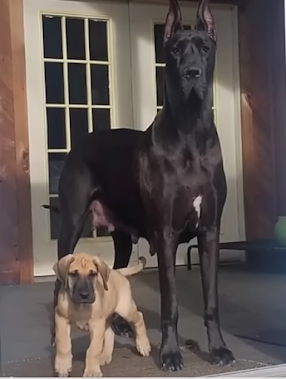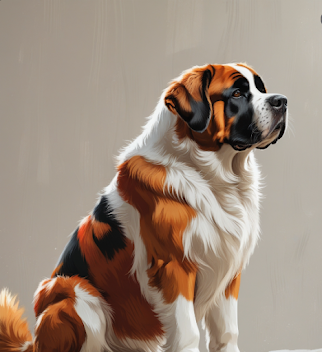Giants Among Us: The Mighty World of Giant Dog Breeds
🐕🦺 Giants Among Us: The Mighty World of Giant Dog Breeds
Introduction:
Giant dog breeds aren't just bigger they're an entirely different experience. These gentle giants capture hearts with their imposing size, noble nature, and often surprising tenderness. Whether you’ve always admired these majestic dogs or are thinking of adding one to your family, understanding their needs and personality traits is crucial. From their fascinating history to their unique quirks, there’s more to these dogs than just their size!
🏰 A Brief History of Giants
Giant dog breeds were originally bred for specific purposes:
-
Protection: Many giant breeds, like the Great Dane and Mastiffs, were used to guard estates, livestock, and even castles.
-
Work: Breeds like Saint Bernards and Newfoundlands were invaluable in hauling heavy loads or rescuing people in dangerous situations, like harsh weather or alpine rescues.
-
War: Some ancient breeds, such as the Tibetan Mastiff, fought alongside soldiers, offering both protection and power.
Their size wasn’t just a feature it was a survival tool.
🐾 Iconic Giant Breeds and Their Unique Traits
Popular Giant Dog Breeds
| Breed | Height/Weight | Personality | Special Note |
|---|---|---|---|
| Great Dane | 28–34 in / 45–90 kg | Friendly, gentle giant | Nicknamed "Apollo of dogs" |
| English Mastiff | 27–32 in / 55–105 kg | Calm, dignified | Among the heaviest breeds |
| Saint Bernard | 25–30 in / 54–82 kg | Patient, loving | Legendary alpine rescuers |
| Newfoundland | 26–28 in / 45–68 kg | Sweet-natured, strong | Excellent swimmers, water rescue |
| Irish Wolfhound | 30–35 in / 48–82 kg | Quiet, noble | Tallest breed in the world |
| Tibetan Mastiff | 24–30 in / 32–68 kg | Independent, protective | Ancient guardian breed |
🧬 Giant Build: Why They’re Different
Key Features:
-
Bones & Joints: These dogs have much heavier bones and joints, which makes them prone to joint issues like hip dysplasia.
-
Growth Rate: Giant dog breeds grow explosively fast as puppies, so their nutrition must be managed carefully.
-
Life Expectancy: Unfortunately, many giant breeds have a shorter life expectancy, typically around 6–10 years.
-
Temperament: While they’re often calm and slow-moving, early training is essential, especially to handle their size effectively.
❤️ Living With a Giant: What to Expect
Living with a Giant Dog: Key Considerations
-
Space Needs: Big dog, big space! Make sure your home is large enough for a giant breed, or at least have a big heart to accommodate their needs.
-
Costs: From food to vet bills, owning a giant dog breed can be expensive. Be prepared for higher costs in food, medical care, and dog supplies.
-
Training: With their size and strength, early obedience training is crucial. Imagine managing an 82 kg dog pulling on the leash!
-
Commitment: Giant dog breeds form deep bonds with their families. They’re loving, loyal, and expect attention and care.
📸 Giants in Modern Times: Why They’re More Than Just Pets
Today, giant breeds are more than just large dogs. They’re family protectors, therapy dogs, and loyal companions. Some are even social media stars thanks to their lovable, oversized "puppy" energy and heart-melting expressions.
Owning one is like living with a gentle elephant. It’s challenging but incredibly rewarding, and the bond you form is worth every moment.
🐕🦺 Living with a Great Dane: A Gentle Giant’s Heartwarming Journey
My Great Dane, a true gentle giant, is a perfect example of the breed's sweet nature. He follows me everywhere yes, even into the bathroom! His affection is unwavering, and he’s not shy about letting everyone know how much he loves to be around them. He’s particularly fond of small dogs and often invites them to play, though most local dogs are too intimidated by his size to accept. It’s a funny and sometimes surprising sight when they flee at the mere sight of him.
What’s amazing is that despite his size, my Dane is a total sweetheart. He adores face rubs, especially when I use a towel. He’s always ready to stand by me, patiently waiting for his turn at grooming time. When it’s walk time, there’s no holding back he knows the moment I pick up the leash and can barely contain his excitement.
What I appreciate most is how well-behaved he is around other dogs. He’s friendly, and when I say "no fighting," he listens, which is impressive for a dog of his size.
💡 Final Thoughts on Giant Dog Breeds
Owning a giant breed like a Great Dane or Saint Bernard is a unique experience. They may be large in size, but their hearts are even bigger. While they come with special needs and considerations, their loyalty and affection are unmatched. So, if you’re thinking about welcoming a gentle giant into your home, be prepared for a love that’s larger than life.
🐕🦺 Coming Up: Other Mighty Giants
While we've covered some of the most popular giant breeds, there are many more magnificent giants in the canine world. In future posts, we’ll dive into the fascinating lives of other giants such as:
-
Chinese Tibetan Mastiffs: Ancient guardians known for their formidable presence and royal history.
-
Bully Kutta: A massive, powerful breed with an incredible loyalty to its family.
-
Kangal: Renowned for its protective instincts and bond with livestock.
-
Caucasian Shepherd: Fierce protectors that can deter wolves and other predators.
And much more!
Stay tuned as we explore these extraordinary breeds in detail, sharing insights, care tips, and everything you need to know about living with these noble giants.
📸 Share Your Gentle Giant!
Do you have a gentle giant in your life? Share your experiences with us in the comments or tag us on Instagram. We’d love to see your lovable, oversized dogs in action!
Mighty Great Danes
English Mastiff
Saint Bernard

















.jpeg)
Comments
Post a Comment